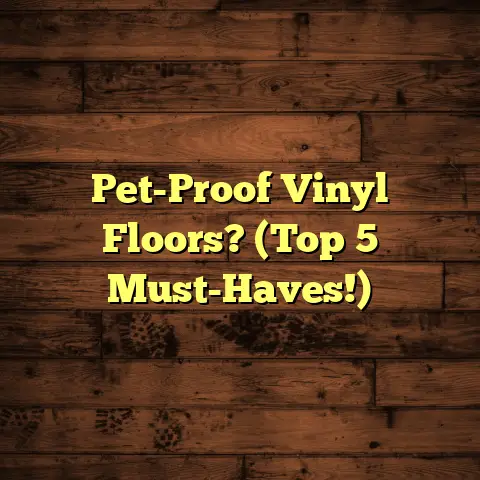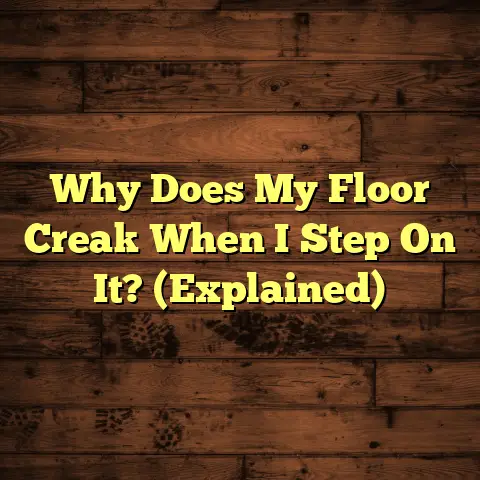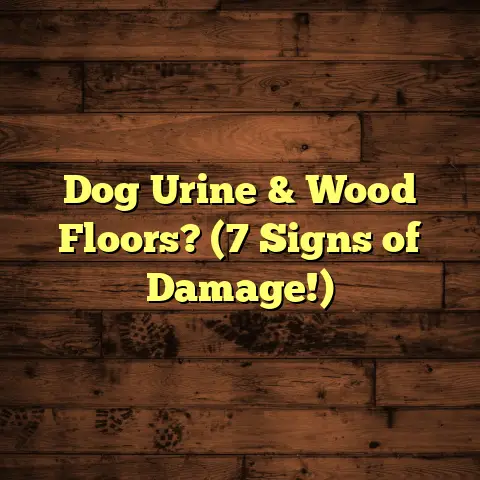How To Dry Floors After A Flood (1 Urgent Step!)
Flooding. Just the word sends shivers down my spine. As a flooring contractor, I’ve seen firsthand the devastation it can wreak on homes and businesses.
Water damage isn’t just about the immediate mess; it’s about the long-term consequences like mold, structural issues, and a whole lot of headaches.
And let’s be honest, dealing with a flooded floor isn’t exactly a walk in the park. But, believe me, acting fast and smart can save you a ton of money and stress.
That’s why I’m writing this guide. I want to give you the lowdown on how to effectively dry your floors after a flood, focusing on the single most crucial step you need to take immediately.
Trust me, getting this right can make all the difference.
Section 1: Understanding the Impact of Flooding on Floors
Okay, so you’ve got water in your house. Now what? Well, the first thing to understand is that not all floors are created equal when it comes to handling water.
Let’s break down how different flooring types react to flooding:
-
Hardwood: Oh, hardwood. Beautiful, but also super sensitive. Water can seep into the wood, causing it to swell, warp, and even buckle. It’s like a sponge, and nobody wants a soggy sponge for a floor.
-
Laminate: Laminate is a bit more resilient than hardwood, thanks to its protective layer. However, water can still penetrate through the seams and cause the core to swell and delaminate. I’ve seen some real horror stories with laminate after a flood.
-
Tile: Tile itself is waterproof, which is great! But the grout? Not so much. Water can seep through the grout lines and cause problems underneath, like mold growth. Plus, if the subfloor gets wet, you’re looking at potential issues there too.
-
Carpet: Carpet is basically a breeding ground for mold and mildew after a flood. It soaks up water like crazy, and it’s tough to dry completely. I usually advise clients to replace flooded carpets, honestly.
So, what happens if you leave your floors wet for too long?
Well, besides the obvious squishing sound with every step (annoying, right?), you’re inviting a whole host of problems:
-
Mold Growth: This is the big one. Mold loves damp, dark places, and a flooded floor is basically its dream home. Mold can cause serious health issues, especially for people with allergies or asthma.
-
Odors: That musty, unpleasant smell? That’s mold and mildew doing their thing. It can be tough to get rid of, even after the floors are dry.
-
Warping and Buckling: As I mentioned before, wood and laminate floors can warp and buckle when they get wet. This can make your floors uneven and even dangerous to walk on.
-
Structural Damage: If the water seeps into the subfloor or even the foundation, you could be looking at serious structural damage. This can be incredibly expensive to repair.
I’ve seen cases where people delayed dealing with the water, thinking it would just dry on its own. Big mistake!
According to FEMA, just one inch of flooding can cause over $25,000 in damage to a home. ( https://www.fema.gov/ )
And a study by the EPA found that indoor mold growth can lead to a 50% increase in respiratory illnesses. (https://www.epa.gov/mold)
These aren’t just numbers; they’re real-life consequences.
Prolonged moisture in flooring materials can lead to respiratory problems, allergic reactions, and other health issues. Mold spores can become airborne and circulate throughout your home, affecting everyone inside.
Section 2: The Urgent Step – Removing Water
Okay, enough with the doom and gloom. Let’s talk about what you can actually DO to fix this mess. And the most important thing you can do?
Immediate water removal.
I can’t stress this enough. The faster you get the water out, the less damage it will cause. Think of it like a ticking time bomb.
So, how do you actually remove the water? Here are a few methods:
Using a Wet/Dry Vacuum
This is my go-to method for removing standing water. A wet/dry vacuum is specifically designed to suck up liquids, making it much more efficient than a regular vacuum.
Here’s how to use it effectively:
-
Choose the Right Vacuum: Make sure your vacuum is actually rated for wet use. Don’t try to use a regular vacuum; you’ll fry the motor. I recommend a heavy-duty model with a large tank capacity.
-
Attach the Right Nozzle: Use a wide nozzle attachment to cover more surface area. Some vacuums come with special attachments for water extraction.
-
Start Vacuuming: Begin at one end of the room and work your way across, overlapping each pass slightly.
-
Empty the Tank Frequently: Don’t let the tank get too full, or you’ll lose suction. Empty it into a sink, tub, or outside drain.
-
Clean the Vacuum: After you’re done, clean the vacuum thoroughly to prevent mold growth inside the tank.
Pro Tip: Look for a wet/dry vacuum with a pump. These models can automatically pump the water out as you vacuum, saving you the hassle of emptying the tank.
Manual Methods
If you don’t have a wet/dry vacuum, or if you’re dealing with a smaller area, you can use manual methods like:
-
Buckets: Scoop up the water and dump it outside or down a drain.
-
Mops: Use a mop to soak up the water and then wring it out.
-
Towels: Lay down towels to absorb the water, then wring them out.
These methods are more labor-intensive, but they can be effective for small spills or hard-to-reach areas.
Coordination is key! Even if you’re using a wet/dry vac, have someone follow behind with a mop or towels to catch any remaining water.
Importance of Safety
Before you start sloshing around in the water, it’s crucial to take some safety precautions:
-
Turn Off the Electricity: Water and electricity don’t mix. Before you do anything, turn off the power to the affected area at the breaker box.
-
Wear Protective Gear: Wear rubber boots, gloves, and a mask to protect yourself from contaminated water and potential hazards.
-
Be Aware of Hazards: Watch out for sharp objects, debris, and slippery surfaces.
Step-by-Step Guide to Water Removal
Okay, let’s get down to business. Here’s a step-by-step guide on how to start the water removal process:
-
Assess the Situation: Before you start, take a look around and assess the extent of the damage. How much water are you dealing with? What type of flooring do you have? Are there any obvious hazards?
-
Gear Up: Put on your protective gear: rubber boots, gloves, and a mask.
-
Turn Off the Power: Go to the breaker box and turn off the power to the affected area.
-
Start Removing Water: Begin with the wet/dry vacuum, if you have one. If not, use buckets, mops, or towels.
-
Work Systematically: Start at one end of the room and work your way across, overlapping each pass.
-
Empty Frequently: Empty the vacuum tank or wring out your mop/towels frequently.
-
Don’t Forget the Edges: Pay attention to the edges of the room, where water can accumulate.
-
Keep Going: Keep removing water until you’ve gotten up as much as you possibly can.
Handling Different Flooring Types
The water removal process will vary slightly depending on the type of flooring you have:
-
Hardwood: Be extra careful not to scratch the surface. Use a soft nozzle on the wet/dry vacuum and avoid using abrasive cleaning products.
-
Laminate: Be gentle when wiping up water, as laminate can be easily damaged. Avoid using too much water, as it can seep into the seams.
-
Tile: Tile is pretty durable, but be careful not to damage the grout. Use a grout brush to scrub away any dirt or debris.
-
Carpet: As I mentioned before, carpet is tough to dry. You’ll need to use a carpet extractor or hire a professional to remove as much water as possible.
The Importance of Speed
I can’t stress this enough: time is of the essence. The longer the water sits, the more damage it will cause. Work quickly and efficiently to remove as much water as possible in the first 24-48 hours.
According to the Institute of Inspection Cleaning and Restoration Certification (IICRC), mold can start to grow within 24-48 hours of water damage. (https://iicrc.org/)
Section 3: Comprehensive Drying Techniques
Okay, you’ve removed all the standing water. Great job! But you’re not out of the woods yet.
Even after you’ve gotten up as much water as possible, your floors are still going to be damp. And dampness is a breeding ground for mold and other problems.
That’s why it’s crucial to use secondary drying techniques to ensure that your floors are completely dry.
Using Fans and Dehumidifiers
These are your best friends when it comes to drying floors.
-
Fans: Fans help to circulate air, which speeds up the evaporation process. Place fans strategically around the room, focusing on areas that are particularly damp.
-
Dehumidifiers: Dehumidifiers remove moisture from the air, which helps to dry out the floors more quickly. Place a dehumidifier in the center of the room and let it run continuously.
Here are some tips for maximizing airflow and moisture removal:
-
Position Fans Correctly: Aim the fans at the floors, but don’t place them too close, or you could damage the surface.
-
Use Multiple Fans: The more fans you use, the faster the drying process will be.
-
Empty the Dehumidifier Regularly: Dehumidifiers can fill up quickly, so be sure to empty the tank regularly.
-
Monitor Humidity Levels: Use a hygrometer to monitor the humidity levels in the room. Aim for a humidity level of below 50%.
Equipment Recommendations:
-
Fans: Look for high-velocity fans with adjustable speeds.
-
Dehumidifiers: Choose a dehumidifier with a large capacity and a built-in humidistat.
The Role of Natural Ventilation
Opening windows and doors can also help to dry out your floors, but only if the weather is dry and sunny.
Here are some tips for using natural ventilation effectively:
-
Open Windows and Doors: Open as many windows and doors as possible to create a cross breeze.
-
Choose the Right Time of Day: Open windows and doors during the warmest, driest part of the day.
-
Secure Your Home: Don’t leave your home unattended with windows and doors open.
Monitoring Moisture Levels
It’s crucial to monitor the moisture levels in your floors to ensure that they’re drying properly. You can do this using a moisture meter.
A moisture meter is a device that measures the amount of moisture in a material. You can use it to check the moisture levels in your floors, walls, and other surfaces.
How to Use a Moisture Meter:
-
Choose the Right Setting: Select the appropriate setting for the type of material you’re testing.
-
Insert the Probes: Insert the probes into the material.
-
Read the Meter: The meter will display the moisture level as a percentage.
Interpreting the Readings:
-
Acceptable Moisture Levels: Generally, a moisture level of below 12% is considered acceptable for most flooring materials.
-
Elevated Moisture Levels: If the moisture level is above 12%, it means that the material is still damp and needs more drying time.
Pro Tip: Take multiple readings in different areas of the room to get an accurate picture of the overall moisture levels.
Drying Timeline and Signs of Dryness
The drying time will vary depending on the type of flooring, the extent of the water damage, and the effectiveness of your drying techniques.
Generally, it can take anywhere from a few days to a few weeks for floors to dry completely.
Here are some signs that your floors are completely dry:
-
No Visible Moisture: There should be no visible moisture on the surface of the floors.
-
No Musty Odor: There should be no musty or moldy odor in the room.
-
Normal Moisture Levels: The moisture meter readings should be within the acceptable range.
-
Floors Feel Dry to the Touch: The floors should feel dry to the touch, not damp or sticky.
Pro Tip: Even if your floors seem dry, it’s a good idea to continue running the fans and dehumidifier for a few extra days to ensure that all the moisture is gone.
Section 4: Final Steps and Prevention
Okay, you’ve dried your floors. Congratulations! But there are a few final steps you need to take to ensure that everything is back to normal.
Final Checks
After the floors are dry, inspect them carefully for any signs of damage, such as:
-
Warping: Are the floors uneven or warped?
-
Buckling: Are the floors buckling or lifting up?
-
Discoloration: Are there any stains or discoloration on the surface of the floors?
If you find any damage, you may need to consult a professional flooring contractor to assess the extent of the damage and determine the best course of action.
When to Consult a Professional:
-
Extensive Damage: If the damage is extensive, it’s best to consult a professional.
-
Mold Growth: If you see or smell mold, you should definitely call a professional mold remediation company.
-
Structural Damage: If you suspect structural damage, you should contact a structural engineer.
Preventative Measures
The best way to deal with flooding is to prevent it from happening in the first place. Here are some preventative measures you can take to protect your floors from water damage:
-
Proper Drainage Solutions: Make sure your property has proper drainage to divert water away from your foundation.
-
Sump Pumps: Install a sump pump in your basement to pump out any water that accumulates.
-
Regular Maintenance Checks: Regularly inspect your plumbing, roof, and gutters to identify and fix any potential problems.
-
Water-Resistant Flooring Materials: If you live in a flood-prone area, consider using water-resistant flooring materials like tile or vinyl.
According to the American Society of Home Inspectors (ASHI), regular home maintenance can prevent up to 50% of water damage claims. (https://www.homeinspector.org/)
The Importance of Timely Action and Monitoring
I can’t stress this enough: timely action is crucial when it comes to dealing with water damage. The faster you act, the less damage will occur.
And even after you’ve dried your floors, it’s important to continue monitoring them for any signs of problems, such as mold growth or warping.
By taking proactive measures and acting quickly in emergency situations, you can protect your investment in your flooring and prevent costly repairs down the road.
Conclusion
So, there you have it: a comprehensive guide on how to dry floors after a flood. Remember, the most crucial step is immediate water removal. The faster you get the water out, the less damage it will cause.
But don’t stop there. Be sure to use secondary drying techniques like fans and dehumidifiers to ensure that your floors are completely dry.
And finally, take preventative measures to protect your floors from future water damage.
Flooding can be a devastating experience, but by taking the right steps, you can minimize the damage and get your home back to normal as quickly as possible.
Don’t wait until it’s too late. Take action now to protect your investment and your health.
And please, share this information with others who may benefit from it. You never know when someone might need this knowledge.





